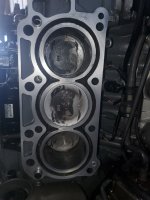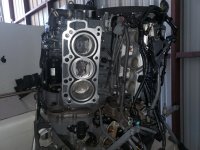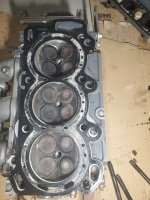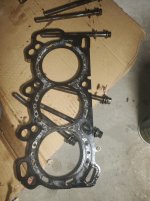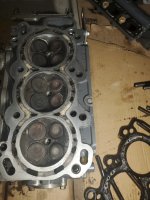wildebeest
Contributing Member
So, I've got a relatively minor, but strange issue with one of my 2004 225s overheating in a very specific situation.
When I launch, idle out of the marina, then get on plane, I get an overheat alarm when at around 3,000 rpm as I get it up on plane. If I turn off the motor, restart, then try to get back on plane, I've got a 50/50 chance of the alarm going off again, but once I get on plane for the first time during the morning without the overheat alarm I will not get an overheat alarm the rest of the day in any circumstances--cruising, WOT, stopping for a few hours and restarting, etc.
My initial thought, which generated my workaround, was that this engine wasn't heating up as fast as the other engine so the thermostat wasn't open when I first tried to get on plane. So my workaround was to idle for at least 5 minutes, then throttle up to 2,000 - 2,500 RPM for a few seconds then throttle back down probably 3 or 4 times before I tried to really give it throttle to get on plane. This resolves the issue, and if I do this every morning that I launch the boat, I never get an overheat alarm and have no issues. But I have to rev it up and down to avoid the alarm. If I just idle out of the marina to try to warm it up at idle, even for 10 minutes at just idle, I still get the alarm, which makes me think it's probably not really a warm up issue. Not a big deal, and that's what I do every time now, but I'd like to know why or what is really the issue. This engine does idle high at 900 RPM when first starting it up for significantly longer than the other engine before coming down to 650 (which is part of what made me think it was a warm up issue).
New thermostats, new water pump (including housing, gaskets, etc.) didn't affect the issue. And the pressure and Pee stream is always strong. In fact, the pressure and pee stream on this engine are always better than the other engine. The other engine is always about 5 psi less than this engine. For example, the engine with the overheat issue is about 25 psi at WOT while the other is about 20 psi at WOT.
Also, when I've hit the exhaust manifolds with an IR temperature gauge immediately after the alarm and I shut the engines down, both seem relatively normal at about 160-165. Water temperature ranges from 75-85F and air temperature ranges from 70-95F, and neither seem to affect it.
My thoughts are that it might be the pressure relief valve, which gets stuck, but frees up after putting pressure against it a few times by revving up (but I don't really understand exactly how it works or how it could cause this) or the temperature sensor itself is simply faulty (and it somehow resolves after it is warm?).
When I launch, idle out of the marina, then get on plane, I get an overheat alarm when at around 3,000 rpm as I get it up on plane. If I turn off the motor, restart, then try to get back on plane, I've got a 50/50 chance of the alarm going off again, but once I get on plane for the first time during the morning without the overheat alarm I will not get an overheat alarm the rest of the day in any circumstances--cruising, WOT, stopping for a few hours and restarting, etc.
My initial thought, which generated my workaround, was that this engine wasn't heating up as fast as the other engine so the thermostat wasn't open when I first tried to get on plane. So my workaround was to idle for at least 5 minutes, then throttle up to 2,000 - 2,500 RPM for a few seconds then throttle back down probably 3 or 4 times before I tried to really give it throttle to get on plane. This resolves the issue, and if I do this every morning that I launch the boat, I never get an overheat alarm and have no issues. But I have to rev it up and down to avoid the alarm. If I just idle out of the marina to try to warm it up at idle, even for 10 minutes at just idle, I still get the alarm, which makes me think it's probably not really a warm up issue. Not a big deal, and that's what I do every time now, but I'd like to know why or what is really the issue. This engine does idle high at 900 RPM when first starting it up for significantly longer than the other engine before coming down to 650 (which is part of what made me think it was a warm up issue).
New thermostats, new water pump (including housing, gaskets, etc.) didn't affect the issue. And the pressure and Pee stream is always strong. In fact, the pressure and pee stream on this engine are always better than the other engine. The other engine is always about 5 psi less than this engine. For example, the engine with the overheat issue is about 25 psi at WOT while the other is about 20 psi at WOT.
Also, when I've hit the exhaust manifolds with an IR temperature gauge immediately after the alarm and I shut the engines down, both seem relatively normal at about 160-165. Water temperature ranges from 75-85F and air temperature ranges from 70-95F, and neither seem to affect it.
My thoughts are that it might be the pressure relief valve, which gets stuck, but frees up after putting pressure against it a few times by revving up (but I don't really understand exactly how it works or how it could cause this) or the temperature sensor itself is simply faulty (and it somehow resolves after it is warm?).



